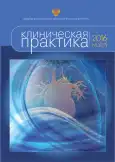VASCULAR WALL CONDITION, GUT MICROBIOTA COMPOSITION, AND DIET IN PATIENTS WITHOUTCARDIOVASCULAR DISEASES
- Authors: Kashtanova DA1, Tkacheva ON2, Egshatyan LV3, Plokhova EV1, Popenko AS4, Tyakht AV4, Alexeev DG5, Kotovskaya Y.V2, Boytsov SА1
-
Affiliations:
- Государственный научно-исследовательский центр профилактической медицины
- Российский геронтологический научно-клинический центр
- Эндокринологический научный центр
- Федеральный научно-клинический центр физико-химической медицины
- Московский физико-химический институт
- Issue: Vol 7, No 3 (2016)
- Pages: 62-72
- Section: Articles
- URL: https://journals.rcsi.science/clinpractice/article/view/8110
- DOI: https://doi.org/10.17816/clinpract7362-72
- ID: 8110
Cite item
Full Text
Abstract
Full Text
##article.viewOnOriginalSite##About the authors
D A Kashtanova
Государственный научно-исследовательский центр профилактической медицины
Email: dr.kashtanova@gmail.com
аспирант отдела Изучения процессов старения и профилактики возраст-ассоциированных заболеваний, Государственный научно-исследовательский центр профилактической медицины
O N Tkacheva
Российский геронтологический научно-клинический центр
Email: Tkacheva@rambler.ru
д.м.н., директор Российского геронтологического научно-клинического центра
L V Egshatyan
Эндокринологический научный центр
Email: lilit.egshatyan@yandex.ru
к.м.н., старший научный сотрудник, Эндокринологический научный центр
E V Plokhova
Государственный научно-исследовательский центр профилактической медицины
Email: evplokhova@gmail.com
к.м.н., научный сотрудник отдела Изучения процессов старения и профилактики возраст-ассоциированных заболеваний, Государственный научно-исследовательский центр профилактической медицины
A S Popenko
Федеральный научно-клинический центр физико-химической медицины
Email: a.s.popenko@niifhm.ru
к.б.н., младший научный сотрудник лаборатории биоинформатики, Федеральный научно-клинический центр физико-химической медицины
A V Tyakht
Федеральный научно-клинический центр физико-химической медицины
Email: at@niifhm.ru
к.б.н., научный сотрудник лаборатории биоинформатики, Федеральный научно-клинический центр физико-химической медицины
D G Alexeev
Московский физико-химический институт
Email: exappeal@gmail.com
к.б.н., заведующий лабораторией сложных биологических наук Московский физико-химический институт
Yu V Kotovskaya
Российский геронтологический научно-клинический центрд.м.н., профессор, заведующая лабораторией сердечно-сосудистого старения, Российский геронтологический научно-клинический центр
S А Boytsov
Государственный научно-исследовательский центр профилактической медицины
Email: prof-boytsov@mail.ru
д.м.н., профессор, директор центра, Государственный научно-исследовательский центр профилактической медицины
References
- Kohn J.C., M.C. Lampi, C.A. Reinhart-King. Age-related vascular stiffening: causes and consequences. Front Genet, 2015; 6:112.
- Karlsson F.H., F. Fak, I. Nookaew, et al., Symptomatic atherosclerosis is associated with an altered gut metagenome. Nat Commun, 2012; 3: 1245.
- GregoryJ.C., J.A. Buffa, E. Org, et al., Transmission of atherosclerosis susceptibility with gut microbial transplantation. J Biol Chem, 2015. 290(9): p. 5647-60.
- Rossi M., K.L. Campbell, D.W. Johnson, et al. Protein-bound uremic toxins, inflammation and oxidative stress: a cross-sectional study in stage 3-4 chronic kidney disease. Arch Med Res, 2014; 45(4): p. 309-17.
- Gulhan B., K. Turkmen, M. Aydin, et al., The Relationship between Serum Oxalic Acid, Central Hemodynamic Parameters and Colonization by Oxalobacter formigenes in Hemodialysis Patients. Cardiorenal Med, 2015. 5(3): p. 164-74.
- Boutouyrie, P., New techniques for assessing arterial stiffness. Diabetes Metab, 2008. 34 Suppl 1: p. S21-6.
- Stein, J.H., C.E. Korcarz, R.T. Hurst, et al., Use of carotid ultrasound to identify subclinical vascular disease and evaluate cardiovascular disease risk: a consensus statement from the American Society of Echocardiography Carotid Intima-Media Thickness Task Force. Endorsed by the Society for Vascular Medicine. J Am Soc Echocardiogr, 2008; 21(2): 93-111; quiz 189-90.
- Caporaso, J.G., J. Kuczynski, J. Stombaugh, et al., QIIME allows analysis of high-throughput community sequencing data. Nat Methods, 2010; 7(5): 335-6.
- Zhang, H., N. Lu, C. Feng, et al., On fitting generalized linear mixed-effects models for binary responses using different statistical packages. Stat Med, 2011; 30(20): 2562-72.
- Lozupone, C., M. HamadyR. Knight, UniFrac--an online tool for comparing microbial community diversity in a phylogenetic context. BMC Bioinformatics, 2006. 7: p. 371.
- Turnbaugh, P.J., M. Hamady, T. Yatsunenko, et al., A core gut microbiome in obese and lean twins. Nature, 2009; 457(7228): 480-4.
- Eckburg, P.B., E.M. Bik, C.N. Bernstein, et al., Diversity of the human intestinal microbial flora. Science, 2005; 308(5728): 1635-8.
- Human Microbiome Project, C., Structure, function and diversity of the healthy human microbiome. Nature, 2012; 486(7402): 207-14.
- LiuC.,S.M.Finegold,Y.Song,etal.,Reclassification of Clostridium coccoides, Ruminococcus hansenii, Ruminococcus hydrogenotrophicus, Ruminococcus luti, Ruminococcus productus and Ruminococcus schinkii as Blautia coccoides gen. nov., comb. nov., Blautia hansenii comb. nov., Blautia hydrogenotrophica comb. nov., Blautia luti comb. nov., Blautia producta comb. nov., Blautia schinkii comb. nov. and description of Blautia wexlerae sp. nov., isolated from human faeces. Int J Syst Evol Microbiol, 2008; 58(Pt 8): 1896-902.
- Tuovinen E., J. Keto, J. Nikkila, et al., Cytokine response of human mononuclear cells induced by intestinal Clostridium species. Anaerobe, 2013;19: 70-6.
- Park O.J., N.E. Kang, M.J. Chang, et al., Resistant starch supplementation influences blood lipid concentrations and glucose control in overweight subjects. J Nutr Sci Vitaminol (Tokyo), 2004; 50(2): 93-9.
- Kwak J.H., J.K. Paik, H.I. Kim, et al., Dietary treatment with rice containing resistant starch improves markers of endothelial function with reduction of postprandial blood glucose and oxidative stress in patients with prediabetes or newly diagnosed type 2 diabetes. Atherosclerosis, 2012. 224(2): p. 457-64.
- Liu A.H.,Redmon A.H. Jr., Endotoxin: friend or foe? Allergy Asthma Proc, 2001; 22(6): 337-40.
- Ou J., F. Carbonero, E.G. Zoetendal, et al., Diet, microbiota, and microbial metabolites in colon cancer risk in rural Africans and African Americans. Am J Clin Nutr, 2013; 98(1):111-20.
- Wu G.D., J. Chen, C. Hoffmann, et al., Linking long-term dietary patterns with gut microbial enterotypes. Science, 2011; 334(6052):105-8.
- Cohen L.J., H.S. Kang, J. Chu, et al., Functional metagenomic discovery of bacterial effectors in the human microbiome and isolation of commendamide, a GPCR G2A/132 agonist. Proc Natl Acad Sci U S A, 2015; 112(35): E4825-34.
Supplementary files






